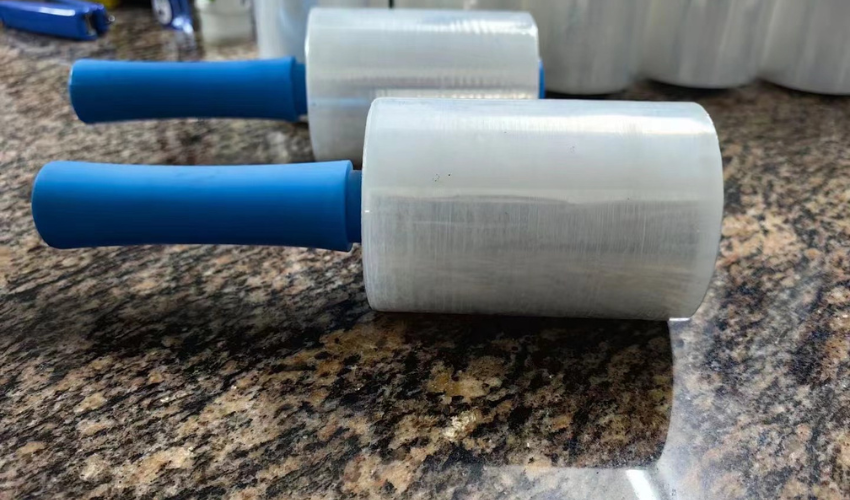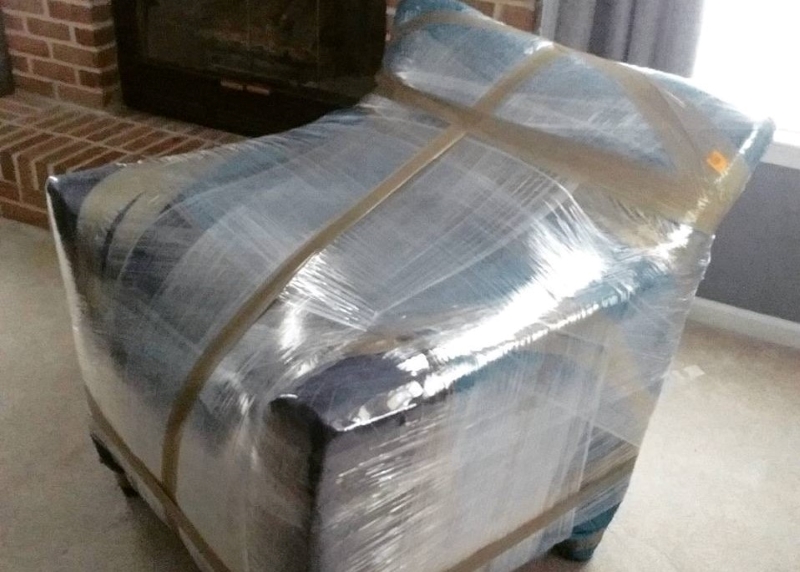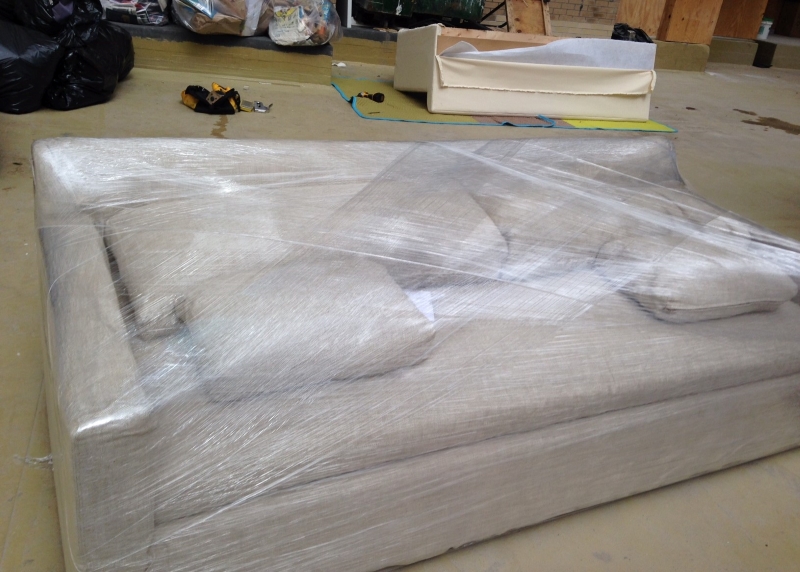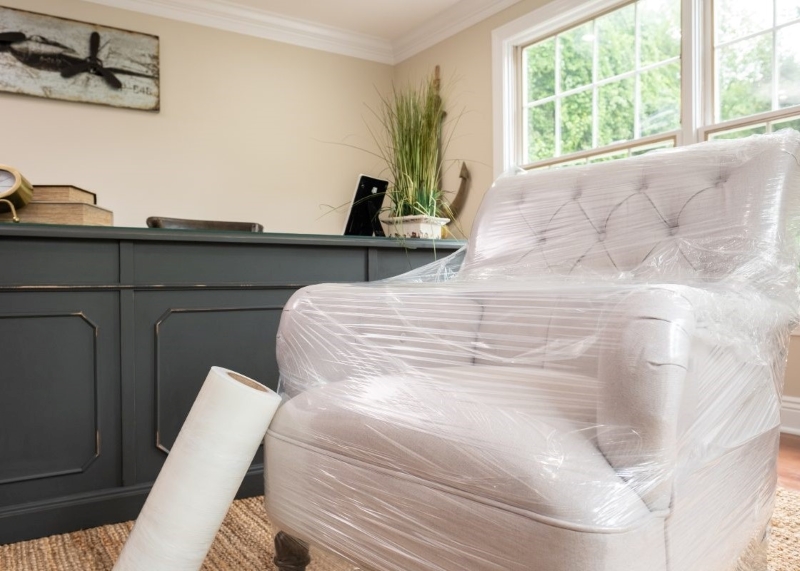
Protecting furniture during moving or storage is essential to ensure it remains in pristine condition. Moving exposes furniture to potential damage from dust, dirt, moisture, and scratches. This is where furniture cling wrap becomes an effective solution. It creates a secure barrier, shielding your valuable pieces from environmental elements and preventing damage. Whether you’re relocating to a new home or storing furniture for an extended period, using furniture cling wrap provides peace of mind. Additionally, having the right tools, like plastic wrap for moving furniture, makes the process easier and more efficient, helping you achieve a smooth and stress-free move or storage experience. Furniture cling wrap is a durable plastic wrap that protects furniture from dust, dirt, and moisture while securely bundling items during moving or storage.
Furniture cling wrap is a versatile and cost-effective solution for protecting furniture during moving or storage. It shields items from environmental factors like dust and moisture, prevents scratches and dents, secures loose components, and is easy to apply and remove without leaving residue. This simple yet effective tool ensures your furniture stays clean, intact, and ready for use, providing peace of mind at an affordable cost.

Furniture cling wrap offers exceptional protection against harmful elements like dust, dirt, and moisture, making it an essential tool for safeguarding your furniture during transit or storage. Whether you’re moving locally or storing items long-term, the large cling wrap acts as a barrier, ensuring your furniture remains clean and free from contaminants. It prevents damage caused by prolonged exposure to moisture, dirt, or dust, preserving the finish and integrity of your valuable pieces.
Moving furniture often leads to scratches, scuffs, or dents, especially on delicate surfaces like polished wood, glass, or upholstered fabrics. Furniture cling wrap forms a durable protective layer around these surfaces, reducing the risk of accidental damage. This protection is particularly useful when transporting large or heavy items that may rub against other furniture, walls, or floors, ensuring your belongings stay intact during the move.
Loose components like drawers, doors, and cushions can shift during a move, potentially causing damage or making furniture harder to handle. Cling wrap effectively secures these parts in place, minimizing the risk of shifting or detachment. By keeping all elements firmly together, the wrap also streamlines the moving process, making it safer and more efficient for both DIY movers and professionals.
Furniture cling wrap is designed for user convenience. Its self-clinging properties make it easy to stretch tightly around your furniture without requiring additional adhesives. Removal is equally simple, leaving no residue or marks behind, ensuring your furniture is ready for use immediately after unpacking. This ease of application and removal saves time and reduces stress, making it a go-to solution for furniture protection.
Compared to the expense of repairing or replacing damaged furniture, cling wrap is a highly affordable option. It provides robust protection for a minimal cost, allowing you to safeguard your furniture without overspending. Whether you’re moving across the city or storing items for years, furniture cling wrap delivers peace of mind and significant savings, making it a practical choice for anyone looking to protect their belongings.
For quick, short-term moves, household furniture cling wrap offers light protection for your furniture. This type of wrap is ideal for local relocations or when your furniture only needs temporary coverage. Cling film for wrapping furniture securely covers the surfaces of chairs, tables, and small couches, shielding them from minor scratches, dust, and dirt during transit.
When moving over long distances or storing furniture for extended periods, heavy duty plastic wrap is a must. It provides extra durability and is more resistant to tearing than household wraps. This type of furniture cling wrap ensures that large and bulky items remain fully protected from harsher environmental conditions, including potential impacts during transport or prolonged exposure in storage facilities.
For those disposing of old or damaged furniture, using saran wrap and bundling stretch film for furniture can simplify the process. This method protects the surrounding environment and other belongings during disposal by tightly containing the furniture’s pieces. Furniture cling wrap used in this context prevents debris, dust, or hazardous materials from spreading while safely transporting the items to disposal sites.
Stretch wrap is another excellent option for wrapping furniture during moves. This versatile material stretches tightly over items, offering a secure fit. Whether used alone or with other packing materials, parcel cling film for wrapping furniture helps hold drawers, doors, and cushions in place, providing both stability and protection during the move.
Shrink wrap differs from cling wrap in that it requires heat to seal tightly around your furniture. It’s often used for larger items or outdoor furniture that needs full protection from weather conditions during long-term storage. Furniture cling wrap is ideal for indoor use, but shrink wrap offers a stronger alternative for outdoor furniture.
For oversized items like couches or dining tables, large cling film wrap for furniture is specifically designed to handle the dimensions of bigger pieces. It provides a continuous layer of protection across the entire surface, preventing dust, dirt, and moisture from reaching your valuable items. When using large cling wrap for furniture, you can cover these items fully in one go, reducing the need for multiple layers of smaller wrap.
Before using furniture cling wrap, it’s important to clean the furniture thoroughly. Dust, dirt, or debris trapped under the wrap could cause scratches or damage over time. Wipe down surfaces with a dry or slightly damp cloth, depending on the material.
When applying cling film for wrapping furniture, start by covering the larger, flat areas and work your way to the edges and corners. For extra security, wrap multiple layers, but avoid wrapping too tightly as it could cause pressure damage. Saran wrap for furniture works well for small or mid-sized pieces that need a snug fit during short moves.
For larger furniture like couches or tables, disassemble the items if possible before using furniture cling wrap. This makes wrapping easier and ensures each component is fully protected during transport or storage.

When preparing for a move or long-term storage, finding high-quality furniture cling wrap is essential for ensuring your furniture is protected from dust, dirt, and damage. There are several reliable sources, both local and online, where you can purchase furniture cling wrap for your needs.
For those who prefer shopping in person, local supply stores such as hardware or moving supply shops are great places to find furniture cling wrap. Retailers like PWP Stretch Film and other specialized moving stores often carry a variety of plastic wraps designed specifically for moving furniture. These stores typically offer options like plastic wrap for moving furniture, making it convenient to pick up everything you need in one visit.
Online shopping offers convenience and a broader selection of furniture cling wrap options. Platforms like PWP Stretch Film provide a wide range of products, including plastic heavy duty cling wrap for furniture, which is perfect for long-distance moves or extended storage. Buying online also allows you to compare prices, read reviews, and choose from bulk purchase options, making it easier to find the best deal for your project.
Purchasing furniture wrap for storage in bulk online can be a cost-effective solution for large moves or professional movers. Many online retailers offer discounts on bulk orders, allowing you to get more value for your money. Additionally, the variety of thicknesses, lengths, and types available online, including large rolls of cling wrap, ensures that you can select the perfect wrap for your specific furniture protection needs.
When protecting furniture during moving or storage, choosing the right wrapping material is essential. Furniture cling wrap stands out due to its unique properties tailored for securing and protecting furniture, while other wrapping films, such as industrial shrink wrap or packing film, are designed for different applications. This comparison highlights the key factors that differentiate furniture cling wrap from other types of wrapping films and explains how these differences affect usability, effectiveness, and suitability for furniture protection.
| Differentiating Factor | Furniture Cling Wrap | Other Wrapping Films | How It Affects the Difference |
|---|---|---|---|
| Purpose | Specifically designed for securing and protecting furniture during moving or storage. | Often used for industrial packaging, palletizing, or general wrapping. | Furniture cling wrap offers better flexibility and protection for irregular shapes, while other films may lack adaptability. |
| Material Thickness | Medium-thick and stretchable for a snug fit around furniture. | Often thicker (shrink wrap) or thinner (packing film). | Furniture cling wrap balances protection and ease of application, while others may be too rigid or tear-prone for furniture. |
| Clinging Properties | Self-clinging, sticks only to itself, avoiding residue or adhesive damage. | May require adhesives or heat to secure, potentially leaving residue. | Furniture cling wrap prevents surface damage, while other films may risk adhesive marks or require more tools to apply. |
| Ease of Use | Easy to apply by hand and remove without tools. | Some require heat guns (shrink wrap) or specialized equipment. | Furniture cling wrap is more user-friendly, especially for DIY moves, compared to labor-intensive alternatives. |
| Durability and Flexibility | Flexible yet durable, ideal for wrapping irregular furniture shapes. | Less flexible or overly rigid, depending on type. | Furniture cling wrap adjusts well to unique furniture contours, while others may not conform effectively. |
| Moisture Protection | Provides excellent moisture and dust protection during storage and transit. | Some (like shrink wrap) provide stronger moisture resistance. | While furniture cling wrap is sufficient for most situations, shrink wrap may be better for extreme conditions. |
| Cost | Affordable and tailored for short-term use. | Costs vary widely based on type (shrink wrap is often more expensive). | Furniture cling wrap offers cost-effectiveness, making it ideal for budget-conscious movers. |
This comparison highlights the specific advantages of furniture cling wrap for protecting furniture during moves or storage, emphasizing its flexibility, ease of use, and suitability for delicate surfaces. While other wrapping films have their place in industrial or heavy-duty applications, furniture cling wrap remains the preferred choice for its balance of performance and cost for home and commercial furniture needs.
When storing and moving furniture, furniture cling wrap plays a pivotal role in protecting items. However, it often works in tandem with other products like moving boxes, mattress bags, bubble pads, wrapping paper, and sealing tape. These products either complement furniture cling wrap to enhance protection or serve as alternatives in specific scenarios. Understanding their relationship helps you choose the right combination for optimal furniture care.
Moving Boxes
Mattress Bags
Bubble Pads
Wrapping Paper
Sealing Tape
These products primarily complement furniture cling wrap rather than replace it. While some, like mattress bags, can act as substitutes in specific scenarios, furniture cling wrap’s versatility and ease of use make it indispensable. By combining it with other tools, you can achieve a comprehensive protective solution tailored to your furniture’s needs.
Furniture cling wrap is a versatile tool for protecting various items during moving and storage. However, different types of furniture and daily necessities require specific handling and precautions to ensure effective use. Below, we divide commonly used items into categories and provide detailed advice for using furniture cling wrap with each.

By tailoring the use of furniture cling wrap to the specific characteristics of different furniture and daily necessities, you can maximize protection and efficiency during moving and storage. This careful approach ensures that each item remains intact and ready for use in its new location.
Although kitchen cling wrap and furniture cling wrap share similar characteristics, such as their self-clinging properties and flexibility, they are distinctly different in terms of purpose, material, and application. Understanding these differences is crucial to using the right product for your needs.
While kitchen cling wrap can occasionally be used for wrapping small, lightweight items, it is not a substitute for furniture cling wrap. Kitchen cling wrap lacks the durability and size needed to secure heavy or large furniture and may tear easily under strain. Conversely, furniture cling wrap is unsuitable for food use as it is not food-grade certified.
Kitchen cling wrap and furniture cling wrap are distinct products tailored for different purposes. To protect furniture effectively during moving or storage, it is essential to use the correct heavy-duty furniture cling wrap, as kitchen cling wrap cannot meet the demands of these tasks.
Furniture cling wrap comes in various widths to accommodate different moving and storage needs. Selecting the right width is essential to ensure efficient wrapping and maximum protection. Below, we introduce the common sizes of furniture cling wrap and explain which household items are best suited for each width.
5-6 Inches (Mini Rolls):
10-15 Inches (Medium Rolls):
18-20 Inches (Large Rolls):
22-30 Inches (Extra-Wide Rolls):
Small Items (e.g., Cords, Kitchen Utensils, Tools):
Medium-Sized Items (e.g., Chairs, Nightstands, Small Appliances):
Large Items (e.g., Sofas, Dressers, Mattresses):
Oversized Items (e.g., Wardrobes, Dining Tables, Industrial Equipment):
The width of furniture cling wrap you choose should match the size and type of items you’re transporting or storing. By selecting the appropriate roll size, you can ensure efficient and secure wrapping for all your furniture and household items.
Cling film, also known as plastic wrap, is commonly used in kitchens to wrap food items. However, it is not the best choice for wrapping furniture. While cling film can protect furniture from dust and some moisture, its clingy nature makes it less effective for protecting furniture during moves or storage. It may leave sticky residues, is not very durable, and can trap moisture, potentially leading to damage or mold. For temporary protection against light dust, cling film might suffice but isn’t recommended for long-term use or during transportation.
For protecting your furniture, whether during transportation or storage, bubble wrap and furniture pads are the best choices. Bubble wrap offers excellent protection against impacts and scratches and is particularly useful for delicate items or surfaces. Furniture pads, also known as moving blankets, provide excellent padding and cover, protecting against dirt, dust, and minor impacts. They are reusable and can cover larger pieces of furniture effectively. Moreover, stretch wrap (plastic film that sticks to itself) can be used to secure the pads or bubble wraps around the furniture, ensuring they stay in place and offer maximal protection.
Furniture wrap is often referred to as stretch wrap or plastic wrap. In the context of moving and storing, it’s specifically called moving wrap or moving plastic. This type of material is designed to adhere to itself without sticky adhesives, making it ideal for securing furniture pads and bubble wraps around items without leaving any residue. Stretch wrap comes in various thicknesses and sizes, allowing for flexibility based on the type of furniture and the level of protection needed.
Storing furniture wrapped in plastic, such as shrink wrap or stretch wrap, is common but requires caution. While plastic wrap protects against dust, dirt, and minor physical damages, it can trap moisture, especially in non-climate-controlled environments. This can lead to mold and mildew growth, damaging your furniture. For better results, it’s advisable to first wrap furniture in breathable material like moving blankets, then use plastic wrap for an additional layer of protection against dust and moisture. Ensure the storage area is dry and well-ventilated to prevent any moisture-related damages.
When moving furniture, protective wrapping is essential to prevent scratches, dents, and dirt. The best materials for wrapping furniture are:
Furniture pads or moving blankets: These thick, padded covers protect against impact and surface damage.
Plastic stretch wrap (cling wrap): Ideal for securing drawers and cushions in place and keeping dirt and moisture out.
Bubble wrap: Provides cushioning for fragile or delicate furniture parts like glass tabletops.
Cardboard or foam sheets: Protect corners and edges prone to damage.
Before wrapping, clean and dry the furniture to avoid trapping dirt or moisture. Use stretch wrap for upholstered items to prevent stains and ensure they remain dust-free. Avoid directly wrapping wood or leather in plastic for long durations, as it can cause condensation and damage. Always secure the wrapping with tape or straps for a firm hold.
To wrap a couch for moving:
Clean and dry the couch: Remove debris and dust to avoid trapping dirt.
Disassemble if possible: Remove cushions, legs, or other detachable parts for easier handling.
Use stretch wrap: Wrap the entire couch tightly in plastic wrap to protect against moisture, dirt, and stains. Stretch wrap is ideal for securing cushions to the couch.
Cover with furniture blankets: For added protection, place moving blankets over the couch before using the plastic wrap.
Protect corners and edges: Use foam padding or cardboard on areas prone to impact.
Secure the wrapping: Tape the ends of the wrapping to keep it in place.
Label the couch: Mark fragile or special handling needs.
Proper wrapping ensures the couch remains clean and undamaged during transport.
To wrap a dresser for moving:
Empty the drawers: Remove all items to reduce weight and prevent damage.
Secure drawers: Use stretch wrap to keep drawers closed during the move. Alternatively, tape them shut with painter’s tape to avoid residue.
Protect surfaces: Place a furniture blanket over the dresser to shield it from scratches.
Wrap with stretch wrap: Cover the entire dresser tightly in plastic wrap to keep the blanket in place and provide extra protection against dirt and moisture.
Use corner guards: Add foam or cardboard guards to protect sharp corners.
Lift carefully: Use a dolly or hand truck to transport the dresser to avoid straining its structure.
These steps ensure your dresser arrives intact and scratch-free at its new location.
Wrapping a sofa in plastic requires careful attention to detail:
Clean and dry: Ensure the sofa is clean to avoid trapping dirt or moisture.
Disassemble if possible: Remove cushions, legs, and other detachable parts.
Stretch wrap the sofa: Start at one end and tightly wrap the entire sofa with plastic stretch wrap. Overlap each layer for complete coverage.
Secure cushions: Use the wrap to attach cushions to the sofa or pack them separately in plastic.
Cover exposed areas: For added protection, use moving blankets before wrapping in plastic.
Avoid over-wrapping: Too many layers can create unnecessary bulk.
Stretch wrap is excellent for protecting against dirt and moisture during a move but avoid using it for extended storage on leather or wooden sofas, as it may trap condensation.
Follow these steps to wrap furniture with plastic wrap:
Prepare the furniture: Clean it thoroughly to remove dirt and debris.
Disassemble where possible: Detach legs, cushions, or other removable parts to make wrapping easier.
Use furniture blankets: Cover delicate or wooden surfaces with blankets before wrapping in plastic to prevent scratches.
Wrap tightly: Start wrapping at one end, applying slight tension to secure the plastic. Ensure all exposed areas are covered.
Secure moving parts: For drawers or doors, stretch wrap is excellent for holding them closed.
Reinforce with tape: Use packing tape to secure the ends of the wrap.
Plastic wrap is ideal for keeping furniture clean, protecting upholstery, and securing loose parts during transit.
Instead of cling film, consider these eco-friendly and practical alternatives:
Furniture blankets or moving pads: Provide excellent protection from scratches and dents.
Reusable fabric wraps: Old sheets or large towels can shield furniture from dust.
Bubble wrap: Perfect for fragile or sensitive areas.
Cardboard sheets: Use for flat surfaces and corners to prevent damage.
Packing paper: Wrap smaller items or furniture components.
Reusable stretch wrap alternatives: Look for biodegradable or reusable stretch wraps.
These substitutes offer protection while minimizing environmental impact. Moving companies often rent or sell eco-friendly options like furniture pads or reusable wraps.
Shrink wrap generally doesn’t damage furniture if used correctly, but precautions are necessary:
Avoid direct application on wood or leather: Prolonged contact may cause condensation, leading to mold or warping.
Use blankets first: Cover delicate or finished surfaces with furniture blankets before wrapping in shrink wrap.
Do not over-tighten: Excessive pressure from wrapping may strain joints or cause structural issues.
Limit storage time: Shrink wrap is best for short-term moves, not long-term storage.
When used appropriately, shrink wrap effectively protects furniture from dirt, moisture, and minor scratches without causing damage.
To wrap a bookcase for moving:
Empty the shelves: Remove books and decorations to reduce weight and avoid damage.
Disassemble if possible: Take apart detachable shelves or components.
Cover with a blanket: Use furniture blankets to protect wood or delicate surfaces.
Wrap in plastic: Use stretch wrap to secure the blanket and shield the bookcase from dirt and moisture.
Protect corners and edges: Add foam or cardboard to guard against impacts.
Secure with tape: Reinforce the wrapping with packing tape for durability.
Following these steps ensures your bookcase is well-protected during transport.
Vinyl wrap on furniture refers to a thin, adhesive vinyl material applied to furniture surfaces. It’s commonly used for:
Aesthetic updates: Change the color or finish of furniture for a refreshed look.
Surface protection: Shield furniture from scratches, stains, and moisture.
Custom designs: Add patterns, textures, or finishes not available in traditional furniture materials.
Vinyl wrap is durable, cost-effective, and available in various finishes like wood grain, matte, or glossy. It’s easy to apply and remove, making it an excellent option for renters or those seeking temporary design changes.

My name is James Thompson, and I’m the editor of this website dedicated to Stretch Film, Pallet Wrap, and Stretch Wrap products.
My passion for packaging began when I noticed the challenges companies face in securing their products efficiently for transportation and storage. This inspired me to delve deep into the world of stretch films and pallet wraps, exploring the latest technologies and best practices.
I aim to provide valuable insights, practical tips, and up-to-date industry trends to assist you in making informed decisions. Whether you’re a small business owner or part of a large corporation, my goal is to support you in optimizing your operations and ensuring your products reach their destination safely.
Thank you for visiting, and I look forward to accompanying you on your journey toward better packaging solutions.
Comments are closed